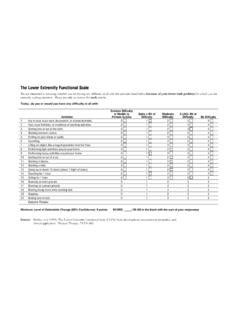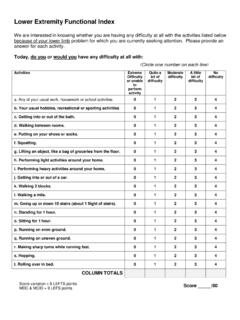Transcription of Lower Extremity Amputation and Prosthetic Rehabilitation
1 Describe the VA Amputation System of Care and why it was developed Identify and describe the phases of Rehabilitation care in the Clinical Practice Guideline for the Rehabilitation of Lower Limb Amputation Describe evidenced-based Prosthetic and Amputation Rehabilitation outcomes Understand the importance of good working relationship between a physical therapist and Prosthetist Identify appropriate fit of Lower Extremity prostheses Describe how the information gained during the lecture can be applied to your clinical practice Each major military operation has resulted in a new cohort of veteran s with combat-related traumatic Amputation .
2 Civil War 70,000 WW1 4,403 WW2 14,912 Korea 1,000 Vietnam 5283 Persian Gulf War 15 OIF/OEF /OND 1643 DoD identified a need for the combat-injured soldier with major traumatic limb loss 1stMilitary Treatment Facility (MTF) for Soldier Amputees created at Walter Reed Hospital 2006 VA collaborates with DoD to meet the needs of these newly combat-injured vets from OIF/OEF while also improving care to all vets with amputations due to medical issues June 2008, Dept of VA Health Systems Committee approved the development of the ASoCand was implemented in FY 2009. Specialized expertise in Amputation care Medical rehab, therapy, Prosthetic technology Multidisciplinary approach Enhance environment of care and ensure consistency VISION -Be a world leader in providing lifelong Amputation careRegional Amputation Centers RACs (7) Medical Director Amputation Rehabilitation Coordinator Program Support Assistant RAC ProsthetistPolytrauma Amputation Network Sites PANS (18) Medical Director Amputation Rehabilitation Coordinator Program Support AssistantAmputation Clinic Teams ACTs (108) Amputation Points of Contact-APOCs (22)
3 PANS-Indianapolis Core Interdisciplinary Amputation Care Team(MD, Prosthetist/Orthotist, PT,OT, & Psychologist) Regularly scheduled Amputee Clinic Clinical Video Tele-amputeeClinics with RACs, ACTs, APOC,CBOCs Accredited Prosthetics Lab 2016 CARF Amputation Specialty Program Accreditation -Inpatient and Outpatient Peer Visitation Program 2010 VET PALS Research (2014) Data collection/ Outcomes Measures Amputation Data Registry / Repository Clinical Practice Guideline following Upper and Lower Limb Amputation Structured document that provides health care practitioners with recommendations for various related health outcomes.
4 Postoperative pain Physical Health Function Psychological support & Well-Being Patient Satisfaction Reintegration Healthcare Utilization Improve patient care by reducing variation in practice Systematizing best practices to achieve best outcomes Adult patients with major Lower Extremity Amputation (bilateral and unilateral) including through-hip, transfemoral, through-knee, transtibial, through-ankle, and partial foot. Cause may be traumatic or non-traumatic. In 2014, million people were living with limb loss in the US. By 2050, that rate is expected to double to million Common Causes of LE Amputation Dysvascular(54%) Peripheral Vascular Disease, Diabetes Mellitus, Chronic Venous Insufficiency Trauma (45%) Cancer and Malignancies (2%)(Us DeptHealth and Human Services) Diabetes affects million people in the US and 189 million people worldwide.
5 By the year 2025 the prevalence of diabetes is expected to rise by 72% to 324 million people globally. (American Diabetes Association) Up to 25%of those with diabetes will develop a foot ulcer. (Singh, Armstrong, AmerMed Assoc 2005) >50% of all foot ulcers (wounds) will become infected, requiring hospitalization and 1 in 5 will require an Amputation .(Lavery, Armstrong, et al. Diabetes Care 2006) Other risk factors for Amputation -PAD, LOPS, insulin dependence, impaired glucose control (Selby and Zhang, Diabetes Care 1995) Ambulatory mobility declined during the period immediately prior to surgery (premorbid) and remained low at 6 weeks post surgery.
6 On average, ambulation improved after surgery up to one year but did not return to premorbidlevels .. (Czernieckiet al, Archives of Physical Med and Rehab 2012) Center for Disease Control and Prevention have suggested the following: declines in diabetic Amputation rates can be attributed to improvements in preventive care (appropriate footwear and patient education) PAVE Prevention of Amputations in Veterans Everywhere LEAP - Lower Extremity Amputation Prevention Dept of Health and Human Services Health Resources and Services Administration PAVE committee developed with VHA directive and recommends:-Daily self inspections-Annual foot exams-High Risk Level Exams-Proper fitted shoesThe continuum of Amputee Care is divided into 5 Specific Phases.
7 Pre-operative Phase Post-operative Phase Pre- Prosthetic Phase Prosthetic Training Phase Long Term Follow-up Phase Decision to amputate Assess functional status and health Consideration of Amputation level, pre-op education, emotional support, physical therapy, nutritional support, pain management Patient Education Learning Assessment-tailor education to meet needs of the individual with limb loss and identify barriers In-depth education to patient and family regarding the procedure, various components of postoperative care, and Rehabilitation activities that will occur Patients should be given appropriate advice and information on Rehabilitation programs, Prosthetic options, and possible outcomes with realistic Rehabilitation goals (Esquenzai& Meier, 1996; Pandian & Kowalske, 1995).
8 VA and Amputee Coalition Next Step: The Rehabilitation Journey After Lower Limb First Step: A Guide for Adapting to Limb Step: A Guide to Preventing and Managing Diabetes and its Complications VA Amputation Education Support Group Amputee Rehab Coordinator, Certified Peer Visitors, Rehab Psychology, Amputee Clinic Evaluation with team Tobacco cessation, coping strategies, support resources, contracture prevention, skin inspection and care, desensitization techniques, shrinker/RRD care, sound limb protection Review of the literature suggest that psychological intervention during the preoperative period is associated with a less complicated postoperative adjustment and grieving experience (Butler et al.)
9 , 1992) Initiate Appropriate Rehabilitation Interventions Cardiovascular Fitness and Endurance Balance Strength/ROM Assess for contractures Sensation Functional Rehab ( ADL, Transfers, Mobility, DME) Time in hospital after Amputation surgery, lasting 5-14 days. Hemodynamic stability, wound healing, prevention of complications Care of residual limb, patient education, physical therapy, occupational therapy, behavioral health PT s-Baseline fxn Post-op Dressings Soft Dressings vs. Rigid Dressing Soft Dressings: ACE Wrap, Shrinkers, Compression Pump Rigid Dressings: NWB rigid dressing, IPOP, Custom removable rigid dressing ( RRD), Prefabricated RRD, Prefabricated pneumatic IPOP Limited evidence is available regarding the management of residual limb volume and what there is focuses primarily on adults with transtibial Amputation in the early postoperative phase (Sanders , 2011) Residual Limb Management encourage patient participation Reduce post-op edema , begin shaping limb with compression, promote incision healing RRD, Shrinker Protect residual limb from trauma RRD for BKA Mirror therapy Mirror therapy Protocol= 15 minutes/day, 4 weeks 18 patients.
10 Six in each of the following: Mirror therapy group, covered mirror therapy group, mental imagery group Mirror therapy group (all 6) reported decreased phantom limb pain; 1 in covered mirror and 2 in mental imagery reported decrease as well; 7 reported increase in phantom limb pain (Chan et al., 2007) 9/12 notassigned to mirror therapy group began 4 week mirror therapy txand all but 1 reported decrease in pain Repeated exposure to virtual images of mirror box may be necessary to improve likelihood of reducing phantom limb pain sxs Focus on Residual Limb Management : volume reduction, pain control, contracture prevention Continued patient and family education Continued coping with loss of a limb Discharge planning from Acute Care Patient avoids looking at or talking about Amputation .






